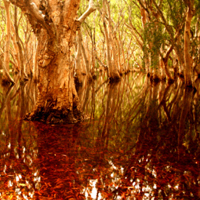Tea tree oil is produced by steam distillation of the leaves and shoots of the tea tree, Melaleuca alternifolia, an amazing wonder that grows to about 20 feet in height. Melaleuca flourishes along the northern-eastern coastal lowlands of New South Wales in Australia and possesses a characteristic flaky, paper-thin, white bark. The oil from melaleuca (tea tree oil) is pale yellow and boasts a fresh camphoraceous odor, similar to that of eucalyptus oil.
Tea tree oil or “melaleuca oil” should not be confused with oils obtained from other melaleuca species such as cajeputl, kanuka, or manuka oils.
Traditionally, tea tree oil has been used to treat skin ailments such as burns, bruises, cuts, abrasions, swellings, insect bites and stings, ringworm, acne, and rosacea. Eastern Australia’s indigenous people used crushed leaves of the tea tree as a traditional medicine to combat coughs and colds. They also utilized the leaves to treat wounds and skin ailments, and to make an infusion to battle sore throats.
Melaleuca appeared on the medicinal radar screen years ago when researchers in Australia discovered that tea tree oil had an antiseptic activity far more potent than the commonly used germicide, carbolic acid. Australian soldiers included tea tree oil in their first aid kits as a disinfectant during World War II.
Read more about Melaleuca …



